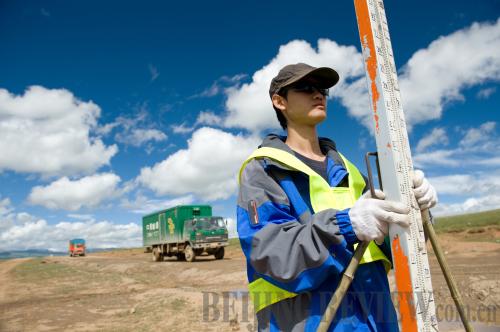|
 |
|
MEASURING LAND: A land surveyor at work near Nagqu Prefecture, Tibet Autonomous Region (YANG GUANG) |
On May 10, the State Bureau of Surveying and Mapping (SBSM) announced 10 major cases of illegal surveying and mapping in China in 2010. Since 2006, surveying and mapping authorities at various levels had investigated more than 3,000 such violations.
Illegal mapping has become increasingly rampant, said the SBSM. There were 215 illegal mapping cases in 2010.
In April 2010, the Shanghai Municipal Office of Surveying and Mapping found a middle school in the city offered a hand-drawn map to visitors of the 2010 World Expo. Subsequent investigations revealed the middle school had printed more than 10,000 copies of the unauthorized maps from February to April 2010. The map was also posted on the school's website for download.
This practice violated Article 8 of China's Provisions on Management of Map Examination and Verification, which stipulates prior to a map's publication, exhibition, media coverage, introduction, production and processing, it must be examined and verified by surveying and mapping authorities according to law.
The Shanghai Municipal Office of Surveying and Mapping demanded the school to stop offering the map and imposed administrative penalties on it.
In March 2010, the Jiangxi Bureau of Surveying and Mapping found an inaccurate map was used in advertisements disseminated by electric appliance producer Midea Group. The map was later found to be unauthorized.
Mapping experts say some people, unaware of or having ignored the territorial claims and sovereignty embodied in the maps, have made such mapping mistakes as drawing the wrong boundaries, omitting important islands or using the wrong colors. Such mistakes may lead to diplomatic disputes.
In addition, some people mark sensitive geographical information onto maps, such as some military facilities and important strategic infrastructures, and leak confidential information and threaten national security.
Illegal surveying has also become a major concern to surveying and mapping authorities. Among the 10 major illegal surveying and mapping cases in 2010, there were three violations of surveying laws and regulations and one of them involved a foreigner.
On February 20, 2010, Tacheng Prefectural Bureau of Surveying and Mapping in northwest China's Xinjiang Uygur Autonomous Region received a report, alleging a Japanese national was surveying in the area with a portable GPS receptor.
Probes found, from January 31 to February 18, this Japanese national collected 598 geographic coordinates under the pretense of traveling and conducting environmental studies. Of the 598 geographic coordinates, 588 were in Xinjiang, including 85 in the Tacheng Military Zone.
The surveying activities of this Japanese national were not approved by the SBSM and breached China's laws. The Tacheng Prefectural Bureau of Surveying and Mapping confiscated relevant surveying devices and results and imposed fines on the person.
Song Chaozhi, Deputy Director of the SBSM, said despite enhanced regulatory efforts in recent years, violations of surveying and mapping laws and regulations still occurred frequently.
In 2006, 571 cases of illegal surveying and mapping were investigated. The number of investigated cases went up to 791 in 2008 and 1,058 in 2009, and then fell to 431 in 2010.
According to mapping experts, China's geographical information service market is expanding rapidly, which makes oversight more difficult. More of a challenge, information obtained from surveying and mapping activities is increasingly accessible due to new IT technologies, which increase the channels through which secrets can be leaked.
Major Cases of Illegal Surveying and Mapping in 2010
- A Japanese national carried out unauthorized surveying activities in Tacheng Prefecture, Xinjiang Uygur Autonomous Region.
- Lujia Road and Bridge Survey and Design Co. Ltd. duplicated confidential surveying results without obtaining prior approval.
- A middle school in Shanghai compiled and published unauthorized 2010 Expo maps.
- Evergrande Real Estate Group's Chongqing subsidiary destroyed surveying marks.
- Hainan Gonghao Convention and Exhibition Co. Ltd. produced and exhibited unauthorized maps.
- Jiangxi Survey and Design Institute produced unacceptable, sub-quality surveying results.
- Chongqing Yongzheng Land and House Survey and Design Co. Ltd. conducted unauthorized surveying activities without obtaining proper qualification.
- Jinhua Daily compiled and published an atlas without approval.
- Shaanxi Yangling Zhengdian Geographical Information Co. Ltd. conducted illegal surveying.
- Jiangxi Midea Refrigeration Equipment Co. Ltd. used unauthorized maps in advertisements.
(Source: State Bureau of Surveying and Mapping) | 